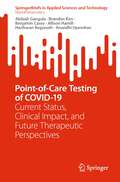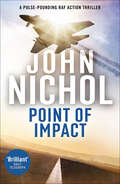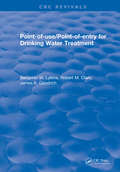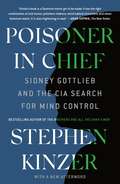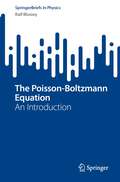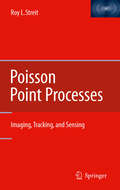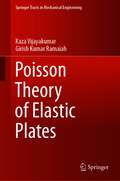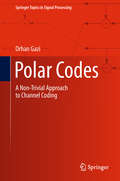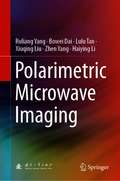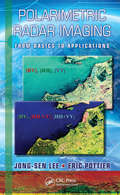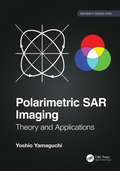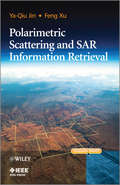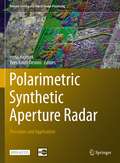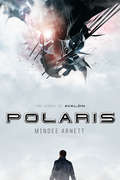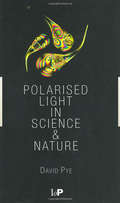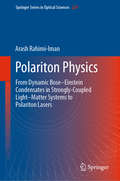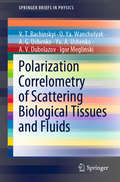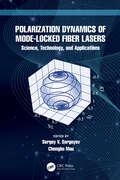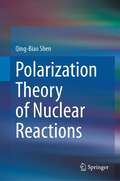- Table View
- List View
Point-of-Care Technologies Enabling Next-Generation Healthcare Monitoring and Management
by Sandeep Kumar Vashist John H.T. LuongThis book describes the emerging point-of-care (POC) technologies that are paving the way to the next generation healthcare monitoring and management. It provides the readers with comprehensive, up-to-date information about the emerging technologies, such as smartphone-based mobile healthcare technologies, smart devices, commercial personalized POC technologies, paper-based immunoassays (IAs), lab-on-a-chip (LOC)-based IAs, and multiplex IAs. The book also provides guided insights into the POC diabetes management software and smart applications, and the statistical determination of various bioanalytical parameters. Additionally, the authors discuss the future trends in POC technologies and personalized and integrated healthcare solutions for chronic diseases, such as diabetes, stress, obesity, and cardiovascular disorders. Each POC technology is described comprehensively and analyzed critically with its characteristic features, bioanalytical principles, applications, advantages, limitations, and future trends. This book would be a very useful resource and teaching aid for professionals working in the field of POC technologies, in vitro diagnostics (IVD), mobile healthcare, Big Data, smart technology, software, smart applications, biomedical engineering, biosensors, personalized healthcare, and other disciplines.
Point-of-Care Testing of COVID-19: Current Status, Clinical Impact, and Future Therapeutic Perspectives (SpringerBriefs in Applied Sciences and Technology)
by Abilash Gangula Brandon Kim Benjamin Casey Allison Hamill Hariharan Regunath Anandhi UpendranThis book highlights the role of point-of-care (POC) testing in the effective management of the coronavirus disease 2019 (COVID-19) pandemic with an in-depth focus on the recent developments in the field, existing gaps, and future directions. POC tests are of utmost importance as they facilitate rapid and decentralized testing without much instrumentation and technical expertise. The book describes the current status of POC COVID-19 testing in three broad categories: Molecular, antigen, and antibody. The advantages, limitations, and adaption of each of the POC tests are reviewed while highlighting their clinical impact in real-world settings. The role of POC testing for COVID-19 screening, diagnosis, and surveillance has been emphasized. The subtle difference between POC and at-home tests is discussed while elaborating on the necessity for the latter for enhancing clinical impacts. A spotlight on the influence of variants on the performance of POC-COVID-19 tests is provided. The consideration of clinical implications of POC testing in hospitals with regards to improving therapeutic options, patient flow, enhancing the infection control measures, and early recruitment of patients into clinical trials is explained. Finally, the future perspectives that will aid the research community in the development of POC tests for COVID-19 or any infectious disease, in general, are presented. Overall, we believe this book can benefit the research community as it (i) presents a comprehensive understanding of current COVID-19 POC testing methods (ii) highlights features required to transform the current tests developed during the past year as POC diagnostics, and (iii) provides insights to address the unmet challenges in the field.
Point of Impact
by John Nichol&“The glimpses of aerial combat are brilliant&” in this pulse-pounding RAF thriller, where it could be pilot error—or a sinister plot. (The Daily Telegraph). They&’re supposed to be routine missions—but one by one, RAF Tempests are crashing in the midst of them. No one knows why, and the Accident Investigation Bureau is blaming pilot error. Suspicious of a cover-up, Flight Lieutenant Drew Miller, whose own friends have been among the fatalities, determines to find out more. He can&’t help wondering if there&’s a conspiracy afoot at the heart of the British military. It soon becomes clear that the key to the mystery is in the cockpit of the Tempest—but how can he unlock it without ending up dead himself? &“The most explosive thriller I&’ve read all year.&” —Andy McNab &“You can smell the hot oil, the sweat and the fear.&” —The Daily Telegraph &“Nichol&’s writing skills are first rate, offering an insight into the world of fighter pilots in a far more accessible way than any work of non-fiction.&”—Daily Express
Point-of-Use/Point-of-Entry for Drinking Water Treatment
by Benjamin W. LykinsThis excellent book is ideal for everyone in the water treatment field, including water treatment managers, operators, supervisors, consultants, laboratories, and regulators. The vast amount of information, the practical approach, and the thoroughness make this a widely used reference.
Poisoner in Chief: Sidney Gottlieb and the CIA Search for Mind Control
by Stephen KinzerThe bestselling author of All the Shah’s Men and The Brothers tells the astonishing story of the man who oversaw the CIA’s secret drug and mind-control experiments of the 1950s and ’60s.The visionary chemist Sidney Gottlieb was the CIA’s master magician and gentlehearted torturer—the agency’s “poisoner in chief.” As head of the MK-ULTRA mind control project, he directed brutal experiments at secret prisons on three continents. He made pills, powders, and potions that could kill or maim without a trace—including some intended for Fidel Castro and other foreign leaders. He paid prostitutes to lure clients to CIA-run bordellos, where they were secretly dosed with mind-altering drugs. His experiments spread LSD across the United States, making him a hidden godfather of the 1960s counterculture. For years he was the chief supplier of spy tools used by CIA officers around the world.Stephen Kinzer, author of groundbreaking books about U.S. clandestine operations, draws on new documentary research and original interviews to bring to life one of the most powerful unknown Americans of the twentieth century. Gottlieb’s reckless experiments on “expendable” human subjects destroyed many lives, yet he considered himself deeply spiritual. He lived in a remote cabin without running water, meditated, and rose before dawn to milk his goats.During his twenty-two years at the CIA, Gottlieb worked in the deepest secrecy. Only since his death has it become possible to piece together his astonishing career at the intersection of extreme science and covert action. Poisoner in Chief reveals him as a clandestine conjurer on an epic scale.
The Poisson-Boltzmann Equation: An Introduction (SpringerBriefs in Physics)
by Ralf BlosseyThis brief book introduces the Poisson-Boltzmann equation in three chapters that build upon one another, offering a systematic entry to advanced students and researchers. Chapter one formulates the equation and develops the linearized version of Debye-Hückel theory as well as exact solutions to the nonlinear equation in simple geometries and generalizations to higher-order equations. Chapter two introduces the statistical physics approach to the Poisson-Boltzmann equation. It allows the treatment of fluctuation effects, treated in the loop expansion, and in a variational approach. First applications are treated in detail: the problem of the surface tension under the addition of salt, a classic problem discussed by Onsager and Samaras in the 1930s, which is developed in modern terms within the loop expansion, and the adsorption of a charged polymer on a like-charged surface within the variational approach. Chapter three finally discusses the extension of Poisson-Boltzmann theory to explicit solvent. This is done in two ways: on the phenomenological level of nonlocal electrostatics and with a statistical physics model that treats the solvent molecules as molecular dipoles. This model is then treated in the mean-field approximation and with the variational method introduced in Chapter two, rounding up the development of the mathematical approaches of Poisson-Boltzmann theory. After studying this book, a graduate student will be able to access the research literature on the Poisson-Boltzmann equation with a solid background.
Poisson Point Processes
by Roy L. Streit"Poisson Point Processes provides an overview of non-homogeneous and multidimensional Poisson point processes and their numerous applications. Readers will find constructive mathematical tools and applications ranging from emission and transmission computed tomography to multiple target tracking and distributed sensor detection, written from an engineering perspective. A valuable discussion of the basic properties of finite random sets is included. Maximum likelihood estimation techniques are discussed for several parametric forms of the intensity function, including Gaussian sums, together with their Cramer-Rao bounds. These methods are then used to investigate: -Several medical imaging techniques, including positron emission tomography (PET), single photon emission computed tomography (SPECT), and transmission tomography (CT scans) -Various multi-target and multi-sensor tracking applications, -Practical applications in areas like distributed sensing and detection, -Related finite point processes such as marked processes, hard core processes, cluster processes, and doubly stochastic processes, Perfect for researchers, engineers and graduate students working in electrical engineering and computer science, Poisson Point Processes will prove to be an extremely valuable volume for those seeking insight into the nature of these processes and their diverse applications.
Poisson Theory of Elastic Plates (Springer Tracts in Mechanical Engineering)
by Kaza Vijayakumar Girish Kumar RamaiahThis groundbreaking book resolves the main lacuna in Kirchhoff theory of bending of plates in the Poisson-Kirchhoff boundary conditions paradox through the introduction of auxiliary problem governing transverse stresses. The book highlights new primary bending problem which is formulated and analyzed by the application of developed Poisson theory. Analysis with prescribed transverse stresses along faces of the plate, neglected in most reported theories, is presented with an additional term in displacements. The book presents a systematic procedure for the analysis of unsymmetrical laminates. This volume will be a useful reference for students, practicing engineers as well as researchers in applied mechanics.
Polar Codes: A Non-Trivial Approach to Channel Coding (Springer Topics in Signal Processing #15)
by Orhan GaziThis book explains the philosophy of the polar encoding and decoding technique. Polar codes are one of the most recently discovered capacity-achieving channel codes. What sets them apart from other channel codes is the fact that polar codes are designed mathematically and their performance is mathematically proven. The book develops related fundamental concepts from information theory, such as entropy, mutual information, and channel capacity. It then explains the successive cancellation decoding logic and provides the necessary formulas, moving on to demonstrate the successive cancellation decoding operation with a tree structure. It also demonstrates the calculation of split channel capacities when polar codes are employed for binary erasure channels, and explains the mathematical formulation of successive cancellation decoding for polar codes. In closing, the book presents and proves the channel polarization theorem, before mathematically analyzing the performance of polar codes.
Polar Explorers for Kids: Historic Expeditions to the Arctic and Antarctic with 21 Activities (For Kids series)
by Maxine SnowdenHeroism and horror abound in these true stories of 16 great explorers who journeyed to the Arctic and Antarctic regions, two exquisite and unique ice wildernesses. Recounted are the exciting North Pole adventures of Erik the Red in 982 and the elusive searches for the "Northwest Passage" and "Farthest North" of Henry Hudson, Fridtjof Nansen, Fredrick Cook, and Robert Peary. Coverage of the South Pole begins with Captain Cook in 1772; continues through the era of land grabbing and the race to reach the Pole with James Clark Ross, Roald Amundsen, Robert Scott, and Ernest Shackleton; and ends with an examination of the scientists at work there today. Astounding photographs and journal entries, sidebars on the Inuit and polar animals, and engaging activities bring the harrowing expeditions to life. Activities include making a Viking compass, building a model igloo, making a cross staff to measure latitude, creating a barometer, making pemmican, and writing a newspaper like William Parry's "Winter Chronicle." The North and South Poles become exciting routes to learning about science, geography, and history.
Polar Ice and Global Warming in Cryosphere Regions (Maritime Climate Change)
by Neloy KharePolar Ice and Global Warming in Cryosphere Regions is based on recent and past climate variabilities data gathered through satellites and spatial-temporal analysis to explain the role of global warming on cryosphere regions such as high-latitude Himalaya, Arctic and Antarctic regions, and the surrounding Southern Ocean and Arctic Ocean. Through several case studies the book describes the atmospheric processes and their interactions with high-latitude regions toward a better understanding of climate variability. Understanding cryosphere regions helps readers develop plausible models for disaster risk management and policy on different polar events.Features Presents a thorough review on climate variability over the Southern Ocean and Antarctica, and the impact of climate variability and global warming on cryosphere regions Explains how the inferred climatological environmental conditions using natural archives may shed light on climate scenarios in cryosphere regions Includes case studies on globally connected geoscientific phenomena in the Himalayan, Arctic, and Antarctic regions Discusses the use of natural archives to explain the current climate scenario in the cryosphere regions Intended for researchers, academics, and graduate students following oceanography, meteorology, or environmental studies, and those working on projects related to climate change in governmental organizations, institutions, and global NGOs, this book outlines ways in which readers can initiate plans and policies to help mitigate the effects of global warming in these regions.
Polar Microbiology: The Ecology, Biodiversity and Bioremediation Potential of Microorganisms in Extremely Cold Environments
by Asim K. Bej Jackie Aislabie Ronald M. AtlasPollution has accompanied polar exploration since Captain John Davis' arrival on the Antarctic continent in 1821 and has become an unavoidable consequence of oil spills in our polar regions. Fortunately, many of the organisms indigenous to Polar ecosystems have the ability to degrade pollutants. It is this metabolic capacity that forms the basis fo
Polarimetric Microwave Imaging
by Ruliang Yang Bowei Dai Lulu Tan Xiuqing Liu Zhen Yang Haiying LiThis book introduces readers to the polarimetric synthetic aperture radar (PolSAR) system, its information processing, and imaging applications. The content is divided into three main parts: Part I, on the research scope of PolSAR, addresses the underlying theory and system design, polarimetric SAR interferometry (PolInSAR), compact PolSAR, and calibration of PolSAR. Part II, which focuses on information processing, highlights the new theories and methods used in PolSAR, such as statistical properties analysis for images, speckle reduction, image enhancement, polarimetric target decomposition, and classification of PolSAR target detection. In turn, Part III, on the applications of polarimetric SAR, discusses the geophysical parameter retrieval of PolSAR data, polarimetric interferometric SAR information processing, compact polarimetric interferometric SAR information processing, and the effects of terrain tilt in azimuth direction on PolSAR data.The book provides a comprehensive and systematic guide to the system, integrating theory and practice, and has a highly application-oriented focus. Presenting new theories, methods and achievements made in polarimetric microwave imaging in recent years, it offers a valuable asset for researchers, engineers and scientists in the area of remote sensing and radar imaging. It can also be used as a reference book for university educators and graduate students.
Polarimetric Radar Imaging: From Basics to Applications (Optical Science and Engineering)
by Jong-Sen Lee Eric PottierThe recent launches of three fully polarimetric synthetic aperture radar (PolSAR) satellites have shown that polarimetric radar imaging can provide abundant data on the Earth’s environment, such as biomass and forest height estimation, snow cover mapping, glacier monitoring, and damage assessment. Written by two of the most recognized leaders in this field, Polarimetric Radar Imaging: From Basics to Applications presents polarimetric radar imaging and processing techniques and shows how to develop remote sensing applications using PolSAR imaging radar. The book provides a substantial and balanced introduction to the basic theory and advanced concepts of polarimetric scattering mechanisms, speckle statistics and speckle filtering, polarimetric information analysis and extraction techniques, and applications typical to radar polarimetric remote sensing. It explains the importance of wave polarization theory and the speckle phenomenon in the information retrieval problem of microwave imaging and inverse scattering. The authors demonstrate how to devise intelligent information extraction algorithms for remote sensing applications. They also describe more advanced polarimetric analysis techniques for polarimetric target decompositions, polarization orientation effects, polarimetric scattering modeling, speckle filtering, terrain and forest classification, manmade target analysis, and PolSAR interferometry. With sample PolSAR data sets and software available for download, this self-contained, hands-on book encourages you to analyze space-borne and airborne PolSAR and polarimetric interferometric SAR (Pol-InSAR) data and then develop applications using this data.
Polarimetric SAR Imaging: Theory and Applications (SAR Remote Sensing)
by Yoshio YamaguchiRadar polarimetry has been highly sought after for its use in the precise monitoring of Earth's surface. Polarimetric SAR Imaging explains the basic concepts of polarimetry and its diverse applications including: deforestation, tree classification, landslide detection, tsunamis, volcano eruptions and ash distribution, snow accumulation, rice field monitoring, urban area exploration, ship detection, among other applications. The explanations use actual data sets taken by Advanced Land Observing Satellite (ALOS and ALOS2). With the increasing problems presented by climate change, there is a growing need for detailed earth observation using polarimetric data. As the treatment of vector nature of radar waves is complex, there is a gap between the theory and the application. Polarimetric SAR Imaging: Theory and Applications addresses and fills this gap. Features: Provides cutting-edge polarimetric applications for earth observation with full color images. Includes detailed descriptions of theory, equations, expansions, and flowcharts, and numerous real examples. Explains concepts, data analysis, and applications in simple and clear language aimed at an intuitive comprehension. Provides specific and unique examples of PolSAR images derived from actual space and airborne systems (ALOS/ALOS2, PiSAR-x/L) Covers the wide range of the radar polarimetry, especially the decomposition of the polarimetry data, an original method developed by the author using the Japanese polarimetric SAR data Illustrated in full color using images generated by polarimetric techniques, this book is easy to understand and use for both student and expert, and is an excellent resource both in the classroom and in the field.
Polarimetric Scattering and SAR Information Retrieval (Wiley - IEEE)
by Ya-Qiu Jin Feng XuTaking an innovative look at Synthetic Aperture Radar (SAR), this practical reference fully covers new developments in SAR and its various methodologies and enables readers to interpret SAR imagery An essential reference on polarimetric Synthetic Aperture Radar (SAR), this book uses scattering theory and radiative transfer theory as a basis for its treatment of topics. It is organized to include theoretical scattering models and SAR data analysis techniques, and presents cutting-edge research on theoretical modelling of terrain surface. The book includes quantitative approaches for remote sensing, such as the analysis of the Mueller matrix solution of random media, mono-static and bistatic SAR image simulation. It also covers new parameters for unsupervised surface classification, DEM inversion, change detection from multi-temporal SAR images, reconstruction of building objects from multi-aspect SAR images, and polarimetric pulse echoes from multi-layering scatter media. Structured to encourage methodical learning, earlier chapters cover core material, whilst later sections involve more advanced new topics which are important for researchers. The final chapter completes the book as a reference by covering SAR interferometry, a core topic in the remote sensing community. Features theoretical scattering models and SAR data analysis techniques Explains the simulation of SAR images for mono- and bi-static radars, covering both qualitative and quantitative information retrieval Chapter topics include: theoretical scattering models; SAR data analysis and processing techniques; and theoretical quantitative simulation reconstruction and inversion techniques Structured to enable both academic learning and independent study, laying down the foundations first of all before advancing to more complex topics Experienced author team presents mathematical derivations and figures so that they are easy for readers to understand Pitched at graduate-level students in electrical engineering, physics, earth and space sciences, as well as researchers MATLAB code available for readers to run their own routines An invaluable reference for research scientists, engineers and scientists working on polarimetric SAR hardware and software, Application developers of SAR and polarimetric SAR, remote sensing specialists working with SAR data – using ESA.
Polarimetric Synthetic Aperture Radar: Principles and Application (Remote Sensing and Digital Image Processing #25)
by Irena Hajnsek Yves-Louis DesnosThis open access book focuses on the practical application of electromagnetic polarimetry principles in Earth remote sensing with an educational purpose. In the last decade, the operations from fully polarimetric synthetic aperture radar such as the Japanese ALOS/PalSAR, the Canadian Radarsat-2 and the German TerraSAR-X and their easy data access for scientific use have developed further the research and data applications at L,C and X band. As a consequence, the wider distribution of polarimetric data sets across the remote sensing community boosted activity and development in polarimetric SAR applications, also in view of future missions. Numerous experiments with real data from spaceborne platforms are shown, with the aim of giving an up-to-date and complete treatment of the unique benefits of fully polarimetric synthetic aperture radar data in five different domains: forest, agriculture, cryosphere, urban and oceans.
Polarimetry of Stars and Planetary Systems
by Ludmilla KolokolovaSummarising the striking advances of the last two decades, this reliable introduction to modern astronomical polarimetry provides a comprehensive review of state-of-the-art techniques, models and research methods. Focusing on optical and near-infrared wavelengths, each detailed, up-to-date chapter addresses a different facet of recent innovations, including new instrumentation, techniques and theories; new methods based on laboratory studies, enabling the modelling of polarimetric characteristics for a wide variety of astronomical objects; emerging fields of polarimetric exploration, including proto-planetary and debris discs, icy satellites, transneptunian objects, exoplanets, and the search for extraterrestrial life; and unique results produced by space telescopes, and polarimeters aboard exploratory spacecraft. With contributions from an international team of accomplished researchers, this is an ideal resource for astronomers and researchers working in astrophysics, earth sciences, and remote sensing keen to learn more about this valuable diagnostic tool. The book is dedicated to the memory of renowned polarimetrist Tom Gehrels.
Polaris
by Mindee ArnettJeth Seagrave and his crew of mercenaries are pulled into one last high-stakes mission in this breathtaking sequel to Mindee Arnett's Avalon, which SLJ called, in a starred review, "an exciting piece of science fiction that keeps up its energy from beginning to end."Jeth Seagrave and his crew are on the run. The ITA, still holding Jeth's mother in a remote research lab, is now intent on acquiring the metatech secrets Jeth's sister Cora carries inside her DNA, and Jeth is desperate to find the resources he needs to rescue his mother and start a new life outside the Confederation. But the ITA is just as desperate, and Jeth soon finds himself pursued by a mysterious figure hell-bent on capturing him and his crew--dead or alive.With nowhere to run and only one play left, Jeth enters into a bargain with the last person he ever thought he'd see again: Daxton Price, the galaxy's newest and most fearsome crime lord. Dax promises to help Jeth, but his help will only come at a price--a price that could mean sacrificing everything Jeth has fought for until now.
Polarised Light in Science and Nature
by J. David PyeThis book describes a number of simple methods for showing that light is polarised and determining the direction of vibration. It is based on a demonstration lecture, called 'Polar Explorations in Light' developed for young audiences, at the Royal Institution of Great Britain.
Polariton Physics: From Dynamic Bose–Einstein Condensates in Strongly‐Coupled Light–Matter Systems to Polariton Lasers (Springer Series in Optical Sciences #229)
by Arash Rahimi-ImanThis book offers an overview of polariton Bose–Einstein condensation and the emerging field of polaritonics, providing insights into the necessary theoretical basics, technological aspects and experimental studies in this fascinating field of science. Following a summary of theoretical considerations, it guides readers through the rich physics of polariton systems, shedding light on the concept of the polariton laser, polariton microcavities, and the technical realization of optoelectronic devices with polaritonic emissions, before discussing the role of external fields used for the manipulation and control of exciton–polaritons. A glossary provides simplified summaries of the most frequently discussed topics, allowing readers to quickly familiarize themselves with the content.The book pursues an uncomplicated and intuitive approach to the topics covered, while also providing a brief outlook on current and future work. Its straightforward content will make it accessible to a broad readership, ranging from research fellows, lecturers and students to interested science and engineering professionals in the interdisciplinary domains of nanotechnology, photonics, materials sciences and quantum physics.
Polarization Correlometry of Scattering Biological Tissues and Fluids (SpringerBriefs in Physics)
by V. T. Bachinskyi O. Ya. Wanchulyak A. G. Ushenko Yu. A. Ushenko A. V. Dubolazov Igor MeglinskiThis book presents a new diagnostic approach that utilizes complex statistical, correlation, fractal, and singular analysis of spatial distribution of the Stokes vector of scattered polarized light in different diffraction zones. The technique is able to identify changes in the distribution of optical axes and the birefringent indices of multi-layered fibrillar networks of biological tissues. The book also presents various scenarios for the formation of polarization singularities in laser speckle images of phase-inhomogeneous, multi-layered biological tissues in terms of the characteristic values of Mueller-matrix images. Moreover, in the context of potential diagnostic applications, it discusses the states of polarization singularities and their changes associated with the pathological abnormalities of the extracellular matrix of human tissues, its spatial peculiarities and structural orientation.
Polarization Dynamics of Mode-Locked Fiber Lasers: Science, Technology, and Applications
by Sergey V. Sergeyev Chengbo MouThis book provides a comprehensive review of the latest research on the science, technology, and applications of mode-locked fiber lasers generating pulse trains with the evolving state of polarization at time scales ranging from a few pulse widths to 10,000 laser cavity round-trip times. It supports readers with a timely source of information on the current novel scientific concepts, and cost-effective schematics, in addition to an overview of the feasible applications. The book aims to demonstrate for the nonlinear science community a newly emerging field of nonlinear science, and so stimulates the development of new theoretical approaches and opens new horizons for the photonics community by pushing boundaries of the existing laser systems towards new applications. The new classes of optical sources and photonic devices explored in this book will be relevant with applications to other fields, including medicine, bio-photonics, metrology, and environmental safety. Key Features • Provides a cutting edge review of the latest emerging science, technology and applications in the field. • Tackles a topic with fast growing interest in USA, Europe and China. • Explores the simple and cheap design and tests of lasers, and outlines the feasible applications.
Polarization Remote Sensing Physics (Springer Remote Sensing/Photogrammetry)
by Lei Yan Bin Yang Feizhou Zhang Yun Xiang Wei ChenThis book elaborates on the physical principles of polarization remote sensing. It explains the reflective characteristics of surface objects and atmosphere separately, including theory, experiment, instrument and application. In addition, it introduces how polarization remote sensing works in advanced research programs as it can be used in aviation, astronomy, disaster risk prevention and navigation fields. This book serves as a fundamental and comprehensive reference for researchers and students.
Polarization Theory of Nuclear Reactions
by Qing-Biao ShenThis book provides the reader with a modern and comprehensive overview of nuclear polarization theory. The understanding of polarization phenomena greatly enriches data obtained from scattering and nuclear reactions by providing information on the interaction that can change spin orientation as well as important verification data for the study of nuclear structures and reaction mechanisms. The author methodically derives the polarization theory of nuclear reactions for various types of elastic scattering and two-body direct reactions between particles of different spin and unpolarized target nuclei with arbitrary spin, as well as the reactions between two polarized light particles and the polarization theory for photon beams. In addition, the polarization theories of relativistic nuclear reactions are rigorously covered in great scope and detail. A chapter on polarized particle transport theory presents the Monte-Carlo method for describing the transport of polarized particles and formalizes the polarized particle transport equation. Here, the author also illustrates a novel and concrete scheme for establishing a polarization nuclear database. Nuclear polarization is important not only for microscopic nuclear structure and reaction studies but also for nuclear engineering, applied nuclear physics, and medical physics. With the development of radioactive beam facilities and, on the theoretical side, the development of consistent microscopic nuclear reaction and structure theories, this book on the polarization theory of nuclear reactions serves as a timely source of reference for students and researchers alike.

